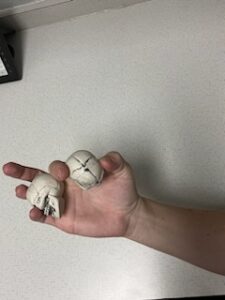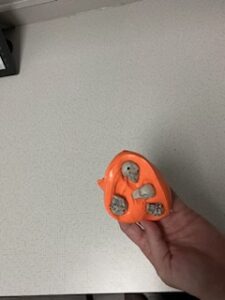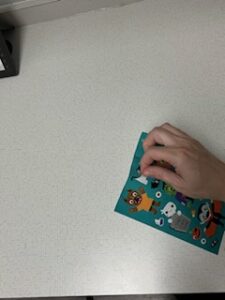
HOW TO MAKE HAND THERAPY FUN IN THE FALL SEASON

Occupational and physical therapy at its basis has a plethora of combinations of opportunity for exercise. Some are straight forward, movement based. Some are functional. Some are simulation of activity. The focus of all activities performed in the clinic and adapted at home is to improve function, return the patient back to what is most important to them, and to rehabilitate the injury within established protocols. Some therapists find that certain activities and exercises have always been beneficial and end up getting into a “rut” of creative solutions. This blog is meant to inspire some alternative choices with a fall-inspired flavor!
2 Inch Plastic Skulls
Have you seen those small skulls all over the place? You can utilize those skulls in therapy in a variety of ways! For patients who need coordination progression and treatment, try having a patient perform the “stress balls” activity with the small skulls instead of stress balls or thermoplastic balls. You can try to increase the speed, change the direction, have the skulls not touch one another, or even have the patient close eyes for the activity. It will help with tendon gliding and excursion, in hand manipulation, fine motor coordination, speed and velocity management for motor control and improve overall dexterity.


2 CM Plastic Skulls
To specifically work on translation of objects, in hand, try the smaller skulls in and out of a plastic cauldron! Have the patient pick up the skulls off the table one at a time and then remove them one at a time from the hand. You can number the items to increase difficulty with the activity as well. Not only will this help with translation and motor control, it will also help with fine motor coordination management and tendon gliding activities. Thenar activation and opponens activation will also improve with this activity.


Putty Options
Speaking of those small skulls, a putty finding activity is another fun and useful idea. Place the skulls in the putty and have the patient find the items and pull them out of the putty. You can also have the patient close their eyes to perform this activity to increase difficulty. Stereognosis is a common impairment after injury, either orthopedic or neurological. This will strengthen stereognosis as well as improve general hand strength and fine motor control.


Stickers
One final option is sticker peeling. Not only can this be fun, it can be pretty difficult after a traumatic hand injury or CMC joint replacement surgery. You can have the patient peel with the thumb and each finger into opposition. You can also have the patient perform this activity at different planes of shoulder motion to increase difficulty and allow for more full body activation tasks.


No matter what activities you choose, make sure therapy is fun around the holidays! This is a perfect time to get out of your “rut” of exercise choice to introduce and progress some variety into the exercises of choice.
 If you would like to learn more about Brittany Moya MS, OTR/L, CHT,
If you would like to learn more about Brittany Moya MS, OTR/L, CHT,
please click HERE for her bio.
